Headquarters EGO Formation 1993 Fields Basic research | Spokesperson Fulvio Ricci | |
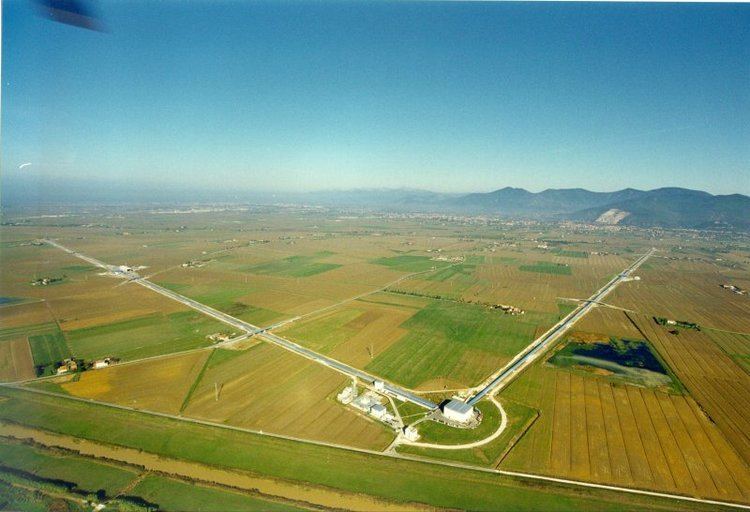 | ||
Type International scientific collaboration Membership CNRS (France), INFN (Italy), NIKHEF (Netherlands), POGRAW (Poland) and RMKI (Hungary) Budget About ten million euros per year Staff More than 320 people contribute to the Virgo experiment Slogan Listening to the cosmic whisper Purpose Gravitation wave detection Affiliations LVC (LIGO Scientific Collaboration and Virgo Collaboration) | ||
The Virgo interferometer is a large interferometer designed to detect gravitational waves predicted by the general theory of relativity. Virgo is a Michelson interferometer that is isolated from external disturbances: its mirrors and instrumentation are suspended and its laser beam operates in a vacuum. The instrument's two arms are three kilometres long and located near Pisa, Italy.
Contents
- History
- Goals
- Effect of a gravitational wave in an optical cavity
- Detection principle
- Detector sensitivity
- Improving the sensitivity
- The instrument
- The initial Virgo detector
- The Advanced Virgo detector
- References
Virgo is part of a scientific collaboration of laboratories from five countries: France and Italy (the two countries behind the project), the Netherlands, Poland and Hungary. Other interferometers similar to Virgo have the same goal of detecting gravitational waves, including the two LIGO interferometers in the United States (at the Hanford Site and in Livingston, Louisiana). Since 2007, Virgo and LIGO have agreed to share and jointly analyze the data recorded by their detectors and to jointly publish their results. Because the interferometric detectors are not directional (they survey the whole sky) and they are looking for signals which are weak and infrequent, simultaneous detection of a gravitational wave in multiple instruments is necessary to confirm the signal and determine its origin.
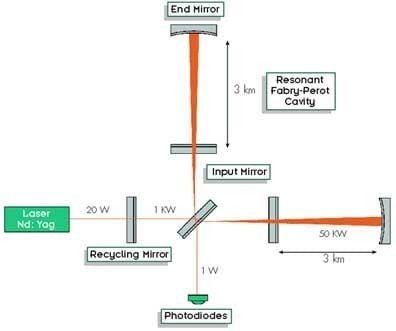
The interferometer is named for the Virgo Cluster of about 1,500 galaxies in the Virgo constellation, about 50 million light-years from Earth. As no terrestrial source of gravitational wave is powerful enough to produce a detectable signal, Virgo must observe the Universe. The more powerful the detector, the further it can see gravitational waves, which then increases the number of potential sources. This is relevant as the violent phenomena Virgo is potentially sensitive to (coalescence of a compact binary system, neutron stars or black holes; supernova explosion; etc.) are rare: the more galaxies Virgo is surveying, the larger the probability of a detection.
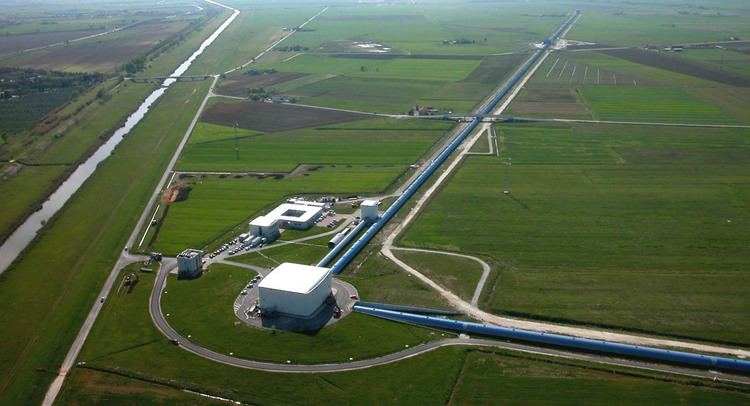
History
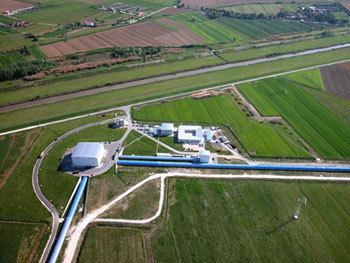
The Virgo project was approved in 1993 by the French CNRS and in 1994 by the Italian INFN, the two institutes at the origin of the experiment. The construction of the detector has started in 1996 in the Cascina site near Pisa, Italy.
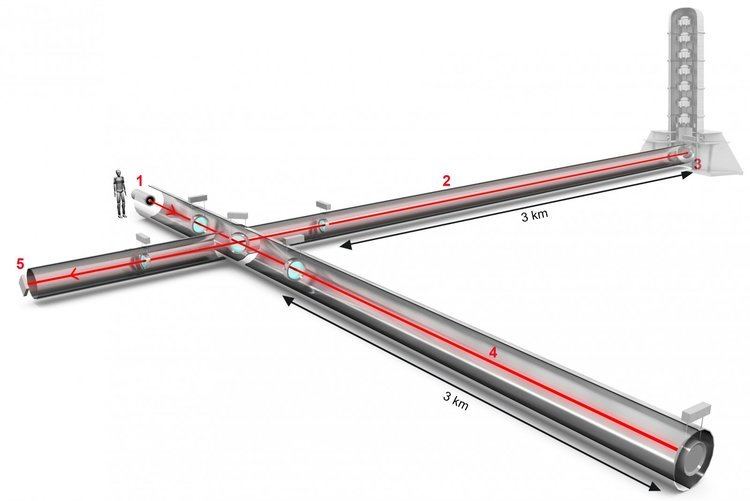
In December 2000, CNRS and INFN have created the European Gravitational Observatory (EGO consortium). EGO is responsible for the Virgo site, in charge of the construction, the maintenance and the operation of the detector, as well as of its upgrades. The goal of EGO is also to promote research and studies about gravitation in Europe. As of December 2015, 19 laboratories plus EGO are members of the Virgo collaboration.

In the 2000s, the "initial" Virgo detector was built, commissioned and operated. The instrument reached its design sensitivity to gravitational wave signals. This long-term endeavour allowed to validate the technical choices made to build Virgo; it also showed that giant interferometers are promising devices to detect gravitational waves in a wide frequency band. Yet, the initial Virgo detector was not sensitive enough to achieve such a detection. Therefore, it was decommissioned from 2011 in order to be replaced by the "advanced" Virgo detector which aims at increasing its sensitivity by a factor of 10. The advanced Virgo detector benefits from the experience gained on the initial detector, such as from the technological improvements made over the past years.
The construction of the initial Virgo detector was completed in June 2003 and several data taking periods followed between 2007 and 2011. Some of these runs were done in coincidence with the two LIGO detectors. Then, a long upgrade phase started; it should reach an important milestone during late 2016. The goal for this second generation detector, called Advanced Virgo, is to reach a sensitivity one order of magnitude better than the initial Virgo detector. This new instrument will then probe a volume of the Universe 1,000 times larger, making detections of gravitational waves very likely.
The year 2016 was an important milestone for the construction of the advanced Virgo detector, although the instrument configuration would not be the final one. After a few month-long commissioning period, the advanced Virgo detector would join the two advanced LIGO detectors ("aLIGO") for a first common data taking period.
Goals
The first goal of Virgo is to directly observe gravitational waves, a straightforward prediction of Albert Einstein's general relativity. The study over three decades of the binary pulsar 1913+16, whose discovery was awarded the 1993 Nobel Prize in Physics, led to indirect evidence of the existence of gravitational waves. The observed evolution over time of this binary pulsar's orbital period is in excellent agreement with the hypothesis that the system is losing energy by emitting gravitational waves. The rotation motion is accelerating (its period, currently 7.75 hours, is decreasing by 76.5 microseconds per year) and the two compact stars get closer by about three meters each year. They should coalesce in about 300 million years. But only the very last moments preceding that particular cosmic collision will generate gravitational waves strong enough to be visible in a detector like Virgo. This theoretical scenario for the evolution of Binary Pulsar B1913+16 would be confirmed by a direct detection of gravitational waves from a similar system, the main goal of giant interferometric detectors like Virgo and LIGO.
On the longer term, after accomplishing the primary goal of discovering gravitational waves, Virgo aims at being part of the birth of a new branch of astronomy by observing the Universe with a different and complementary perspective than current telescopes and detectors. Information brought by gravitational waves will be added to those provided by the study of the electromagnetic spectrum (microwaves, radio waves, infrared, the visible spectrum, ultraviolet, X rays and gamma rays), of cosmic rays and of neutrinos. In order to correlate a gravitational wave detection with visible and localized events in the sky, the LIGO and VIRGO collaborations have signed bilateral agreements with many teams operating telescopes to quickly inform (on the timescale of a few days or a few hours) these partners that a potential gravitational wave signal has been observed. These alerts must be sent before knowing whether the signal is real or not, because the source (if it is real) may only remain visible during a short amount of time.
Effect of a gravitational wave in an optical cavity
In general relativity, a gravitational wave is a space-time perturbation which propagates at the speed of light. It then curves slightly the space-time, which changes locally the light path. Mathematically speaking, if
with
Detection principle
To start with, Virgo is a Michelson interferometer whose mirrors are suspended. A laser is divided into two beams by a Beam splitter tilted by 45 degrees. The two beams propagate in the two perpendicular arms of the interferometer, are reflected by mirrors located at the end of the arms and recombine on the beam splitter, generating interferences which are detected by a photodiode. An incoming gravitational wave changes the optical path of the laser beams in the arms, which then changes the interference pattern recorded by the photodiode.
The signal induced by a potential gravitational wave is thus "embedded" in the light intensity variations detected at the interferometer output. Yet, several external causes—globally denoted as noises—changes the interference pattern perpetually and significantly. Should nothing be done to remove or mitigate them, the expected physical signals would be buried in noise and would then remain undetectable. The design of detectors like Virgo and LIGO thus requires a detailed inventory of all noise sources which could impact the measurement, allowing a strong and continuing effort to reduce them as much as possible. During the data taking periods, dedicated software monitor in real time the noise levels in the interferometer and deep studies are carried out to identify the loudest noises and mitigate them. Each period during which a detector is found to be "too noisy" is excluded from the data analysis: these deadtimes thus need to be reduced as much as possible.
Detector sensitivity
A detector like Virgo is characterized by its sensitivity, a figure of merit providing information about the tiniest signal the instrument could detect—the smaller the value of the sensitivity, the better the detector. The sensitivity varies with frequency as each noise has its own frequency range. For instance, it is foreseen that the sensitivity of the advanced Virgo detector be ultimately limited by:
Virgo is a wide band detector whose sensitivity ranges from a few Hz up to 10 kHz. Mathematically speaking, its sensitivity is characterized by its power spectrum which is computed in real time using the data recorded by the detector. The curve opposite shows an example of a Virgo amplitude spectrum density (the square root of the power spectrum) from 2011, plotted using log-log scale.
Improving the sensitivity
Using an interferometer rather than a single optical cavity allows one to enhance significantly the sensitivity of the detector to gravitational waves. Indeed, in this configuration based on an interference measurement, the contributions from some experimental noises are strongly reduced: instead of being proportional to the length of the single cavity, they depend in that case on the length difference between the arms (so equal arm length cancels the noise). In addition, the interferometer configuration benefits from the differential effect induced by a gravitational wave in the plane transverse to its direction of propagation: when the length of an optical path
Then, one has to "freeze" the various mirrors of the interferometer: when they move, the optical cavity length changes and so does the interference signal read at the instrument output port. The mirror positions relative to a reference and their alignment are monitored accurately in real time with a precision better than the tenth of a nanometre for the lengths; at the level of a few nanoradians for the angles. The more sensitive the detector, the narrower its optimal working point.
Reaching that working point from an initial configuration in which the various mirrors are moving freely is a control system challenge. In a first step, each mirror is controlled locally to damp its residual motion; then, an automated sequence of steps, usually long and complex, allows one to make the transition between a series of independent local controls to a unique global control steering the interferometer as a whole. Once this working point is reached, it is simpler to keep it as error signals read in real time provide a measurement of the deviation between the actual state of the interferometer and its optimal condition. From the measured differences, mechanical corrections are applied on the various mirrors to bring the system closer to its best working point.
The optimal working point of an interferometric detector of gravitational waves is slightly detuned from the "dark fringe", a configuration in which the two laser beams recombined on the beam splitter interfere in a destructive way: almost no light is detected at the output port. Calculations show that the detector sensitivity scales as
The instrument
Seen from the air, the Virgo detector has a characteristic "L" shape with its two 3-km long perpendicular arms. The arm "tunnels" house vacuum pipes with a 120 cm diameter in which the laser beams are travelling under ultra-high vacuum. To increase the interaction between the light and an incoming gravitational wave, a Fabry-Perot optical cavity is installed in each arm as well as a mirror called "recycling mirror" at the instrument entrance, between the laser source and the beam splitter.
Virgo is sensitive to gravitational waves in a wide frequency range, from 10 Hz to 10,000 Hz. The main components of the detector are the following:
The initial Virgo detector
The initial Virgo detector recorded scientific data from 2007 to 2011 during four science runs. There was a shut-down of a few months in 2010 to allow for a major upgrade of the Virgo suspension system: the original suspension steel wires were replaced by glass fibers in order to reduce the thermal noise. After several months of data taking with this final configuration, the initial Virgo detector was shut down in September 2011 to begin the installation of Advanced Virgo.
The Advanced Virgo detector
The Advanced Virgo aims to be 10 times more sensitive than the initial Virgo. Advanced Virgo keeps the same vacuum infrastructure as Virgo, with four additional cryotraps located at both ends of both three-kilometre-long arms to trap residual particles coming from the mirror towers, but the remainder of the interferometer has been significantly upgraded. The new mirrors are larger (350 mm in diameter, with a weight of 40 kg), and their optical performances have been improved. The critical optical elements used to control the interferometer are now under vacuum on suspended benches. A system of adaptive optics will also be installed to correct the mirror aberrations in-situ. In the final Advanced Virgo configuration, the laser power will be 200 W.
A milestone for the Advanced Virgo should be reached in 2016 with the installation of the new detector. A first joint science run with LIGO, in the second half of 2016, will start following a commissioning period of a few months. The full design sensitivity of the Advanced Virgo should be achieved in 2018.
